President
- FMA
- The Fabricator
- FABTECH
- Canadian Metalworking
Categories
- Additive Manufacturing
- Aluminum Welding
- Arc Welding
- Assembly and Joining
- Automation and Robotics
- Bending and Forming
- Consumables
- Cutting and Weld Prep
- Electric Vehicles
- En Español
- Finishing
- Hydroforming
- Laser Cutting
- Laser Welding
- Machining
- Manufacturing Software
- Materials Handling
- Metals/Materials
- Oxyfuel Cutting
- Plasma Cutting
- Power Tools
- Punching and Other Holemaking
- Roll Forming
- Safety
- Sawing
- Shearing
- Shop Management
- Testing and Measuring
- Tube and Pipe Fabrication
- Tube and Pipe Production
- Waterjet Cutting
Industry Directory
Webcasts
Podcasts
FAB 40
Advertise
Subscribe
Account Login
Search
Aluminum Workshop: Shielding gas and porosity
- By Frank Armao
- Updated August 8, 2023
- November 19, 2018
- Article
- Aluminum Welding
In the last issue I pointed out that two factors usually (and wrongly) are blamed for porosity in aluminum welding: contaminated shielding gas and contaminated filler [“Got porosity? Do your homework before assessing blame,” The WELDER, September/October 2018, p. 56]. In that column we discussed the filler wire. This time we will discuss the shielding gas.
Dew point is a standard method to designate the water vapor content of gas. The lower the dew point, the lower the water vapor content of the gas. AWS specifications require a dew point of -76 degrees F or lower for welding gases. This corresponds to a water vapor content of 10 parts per million (PPM) or less. It has been shown that water vapor contents of 20 PPM or more will cause porosity in aluminum welds. You should always order welding-grade shielding gas, which is actually purer than medical grades.
Manufacturing Shielding Gas
Next, let’s look at how shielding gases are manufactured. All industrial gases, except hydrogen and helium, are made by liquefying air and then distilling the liquid to obtain pure gas of the type desired, much like distilling gasoline. Helium is obtained from residues contained in natural gas. Most hydrogen is obtained from a process called steam re-forming, in which natural gas and water react at high temperatures to form hydrogen and carbon dioxide.
For the more common gases such as argon, the liquefaction and distillation are conducted at cryogenic temperatures, below roughly -300 degrees F, so almost all of the water vapor is naturally frozen out. The bulk gas supplied by the major gas manufacturers is therefore almost always very low in water vapor content. However, mistakes do happen, although very rarely. It is worth switching out the bottle of gas if you have a problem, but in 90 percent of the cases, it isn’t the gas that is causing the porosity.
Shielding Gas Bottles
Another problem is the steel gas bottles themselves. These are recycled many times through many users, meaning no one is really sure of their history. If a user runs a bottle down to zero pressure and then stores it with the cylinder valve open, the cylinder will breathe, drawing the surrounding atmosphere inside and then expelling it with temperature changes. I have actually seen cylinders that were very rusty inside because of this, and the rust will hold water vapor. Removing the rust is usually handled by the company that actually fills the cylinder, which pulls a vacuum on every cylinder before refilling. However, mistakes sometimes do happen. So again, the gas might be a problem, but it usually isn’t.
All of this is true for gases purchased from reputable suppliers in industrialized countries. The story changes if you buy cheap shielding gas from a no-name supplier, or if you work in a third-world country. Gas quality in such situations varies widely and can be a big problem. My best recommendation in such cases is to buy your shielding gas from a major manufacturer. Don’t shop for the cheapest brand.
In the end, I’m not telling you not to worry about gas quality. By all means, if you are having porosity problems, try a different bottle of shielding gas. Just don’t assume that your problem is the shielding gas. It usually isn’t.
About the Author

Frank Armao
Aluminum Consulting Inc.
440-479-0239
About the Publication
subscribe now

The Welder, formerly known as Practical Welding Today, is a showcase of the real people who make the products we use and work with every day. This magazine has served the welding community in North America well for more than 20 years.
start your free subscription- Stay connected from anywhere

Easily access valuable industry resources now with full access to the digital edition of The Fabricator.

Easily access valuable industry resources now with full access to the digital edition of The Welder.

Easily access valuable industry resources now with full access to the digital edition of The Tube and Pipe Journal.
- Podcasting
- Podcast:
- The Fabricator Podcast
- Published:
- 04/16/2024
- Running Time:
- 63:29
In this episode of The Fabricator Podcast, Caleb Chamberlain, co-founder and CEO of OSH Cut, discusses his company’s...
- Trending Articles
Sheffield Forgemasters makes global leap in welding technology

ESAB unveils Texas facility renovation

Engine-driven welding machines include integrated air compressors

How welders can stay safe during grinding

The impact of sine and square waves in aluminum AC welding, Part I

- Industry Events
16th Annual Safety Conference
- April 30 - May 1, 2024
- Elgin,
Pipe and Tube Conference
- May 21 - 22, 2024
- Omaha, NE
World-Class Roll Forming Workshop
- June 5 - 6, 2024
- Louisville, KY
Advanced Laser Application Workshop
- June 25 - 27, 2024
- Novi, MI



























